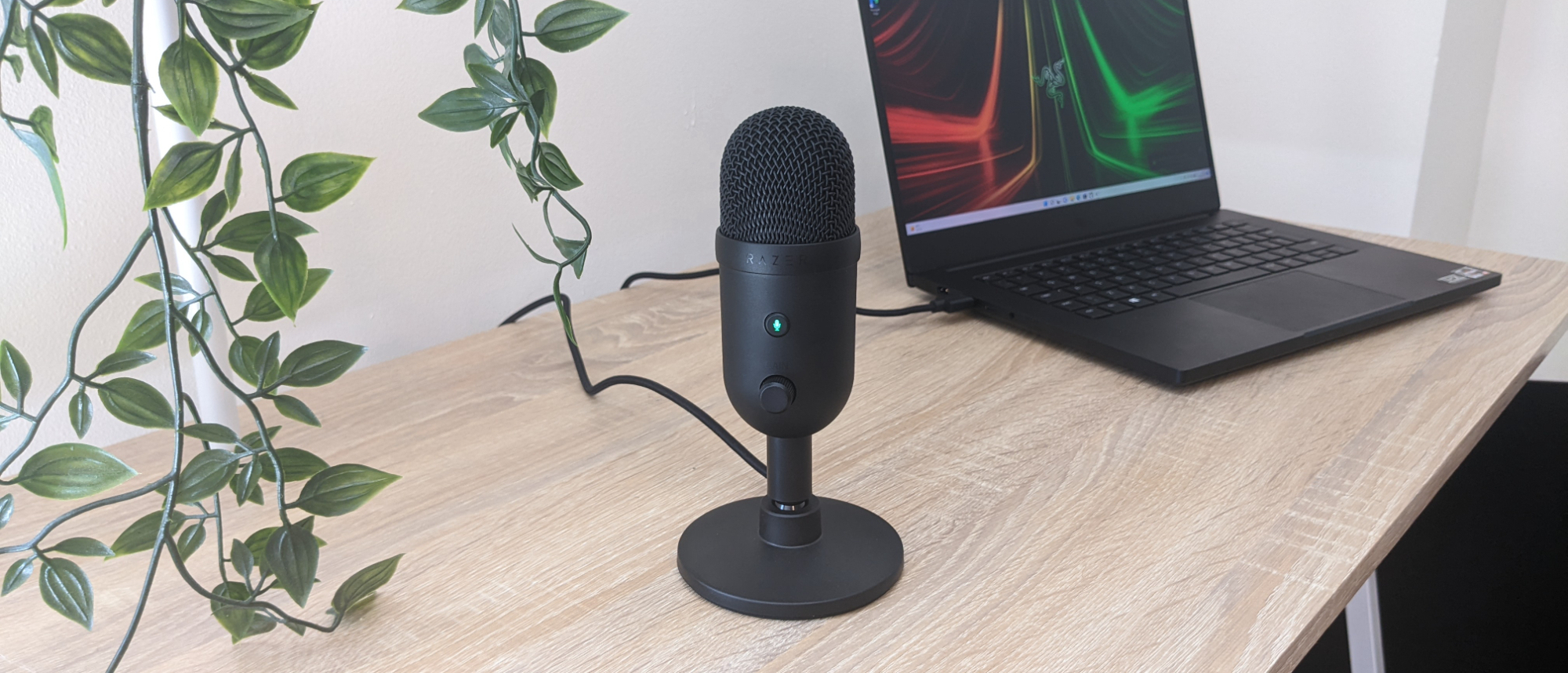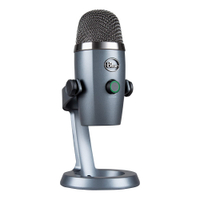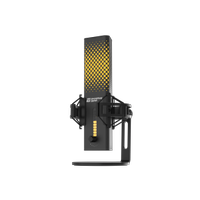TechRadar Verdict
While we like the new aesthetic, the lackluster generational advancements and unimpressive supporting software make this sequel to the classic Seiren X feel like a poor choice within the wider desktop microphone market.
Pros
- +
New design is good
- +
Durable base and braided cable
- +
Easy to set up and use
Cons
- -
No boom arm or pop filter included
- -
Fairly expensive
- -
Razer Synapse software is mediocre
Why you can trust TechRadar
Razer Seiren V2 X: Two-Minute Review
While writing this Razer Seiren X V2 review, I gave some serious thought to the other desktop microphones I’ve tested in the past. Out of the box, the Seiren X V2 feels great; the build quality is robust, and the new design feels more modern than the original Seiren X’s tube-shaped casing.
Visually, it reminds me of the fantastic Blue Yeti, which has long been one of the best microphones available for streamers and podcasters. The new pill-shaped design, with a simple USB-C plugin at the back and a simple button and dial on the front, looks stylish and modern.
Unfortunately, the Razer Seiren X V2’s performance doesn’t live up to its new appearance. While it’s easy to set up and start using, it doesn’t represent much of a generational step forward compared to its predecessor; it’s still got a 25mm condenser inside the microphone head, offering the same frequency response, sample rate, and single ‘supercardioid’ polar pattern.
Given that the V2 X is the same price as the first Seiren X, I would’ve like to see more than just a physical redesign. There is a higher bitrate and slightly better sensitivity here, but these aren’t improvements that the average user will notice.
More to the point, the low base means that unless you’re willing to lean close to the mic or invest in a boom arm, the Seiren V2 X doesn’t pick up sound well enough without increasing the gain, which means an increase in background noise. There’s no included pop filter either, which is a shame.
Lastly, anyone who knows me will be aware that I don’t like Razer Synapse very much - or any proprietary peripheral software, really. But Synapse is at least good to use with Razer keyboards, like the Razer DeathStalker V2 Pro. Here, though, it clashes with the audio settings in Windows 10 and generally doesn’t offer enough to mitigate the Seiren V2 X’s drawbacks.
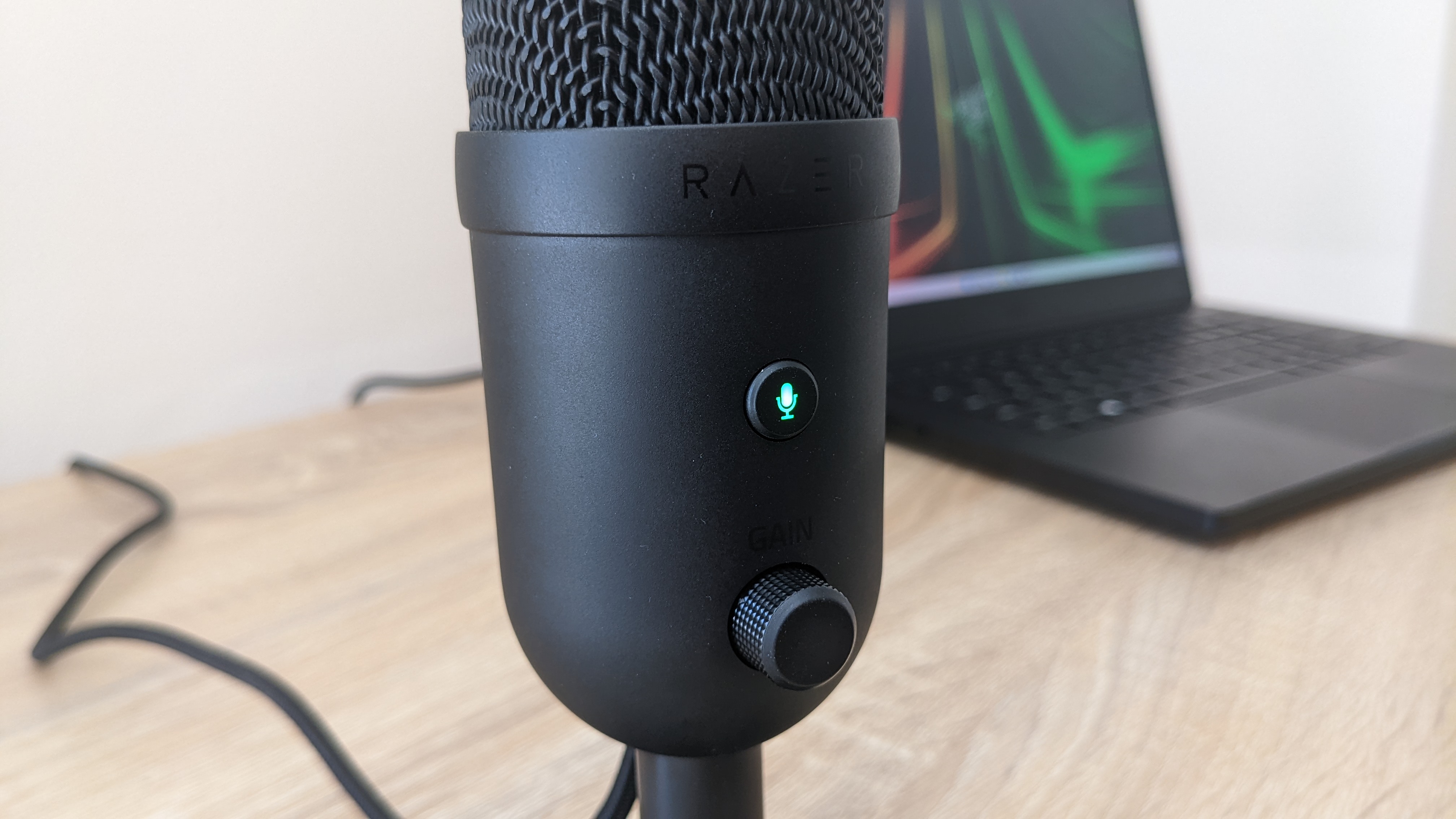
Razer Seiren V2 X: Price and Availability
These are the specs on the Razer Seiren V2 X sent to TechRadar for review:
Connection: USB Type-A
Polar pattern: Cardioid
Sample Rate: 48 kHz
Frequency Response: 20 Hz - 20 kHz
Bitrate: 24 bit
Max SPL: 120 dB
Weight (with stand):
- Standard model costs $100
- No included pop filter or boom arm
- Available direct from Razer and major retailers
The asking price for the Razer Seiren V2 X is $99.99 (£99.99, AU$169.95), which isn’t outrageous for a USB desktop microphone, but is undeniably quite expensive when you consider what it offers. The vastly superior Blue Yeti sits in the same price bracket, while Razer’s own Serien V2 Pro is significantly better at $149.99, and the pint-sized Seiren Mini costs just $49.99.
There’s no pop filter or boom arm - both things you’re likely to want here - available from Razer, so you’ll have to take to Amazon to find third-party ones. The V2 X uses the same threaded screw base as other Razer Serien mics, so it’s not hard to find a boom arm that will support it (though be careful not to cheap out here, as there are plenty of rubbish knock-offs around).
The Seiren V2 X is available in all supported regions directly from Razer, as it ostensibly represents the default option of the brand’s Seiren range in its current generation. If you want to shop sales, it’s available from most major retailers (Amazon, Walmart, Best Buy etc.) too.
- Price and availability: 3/5
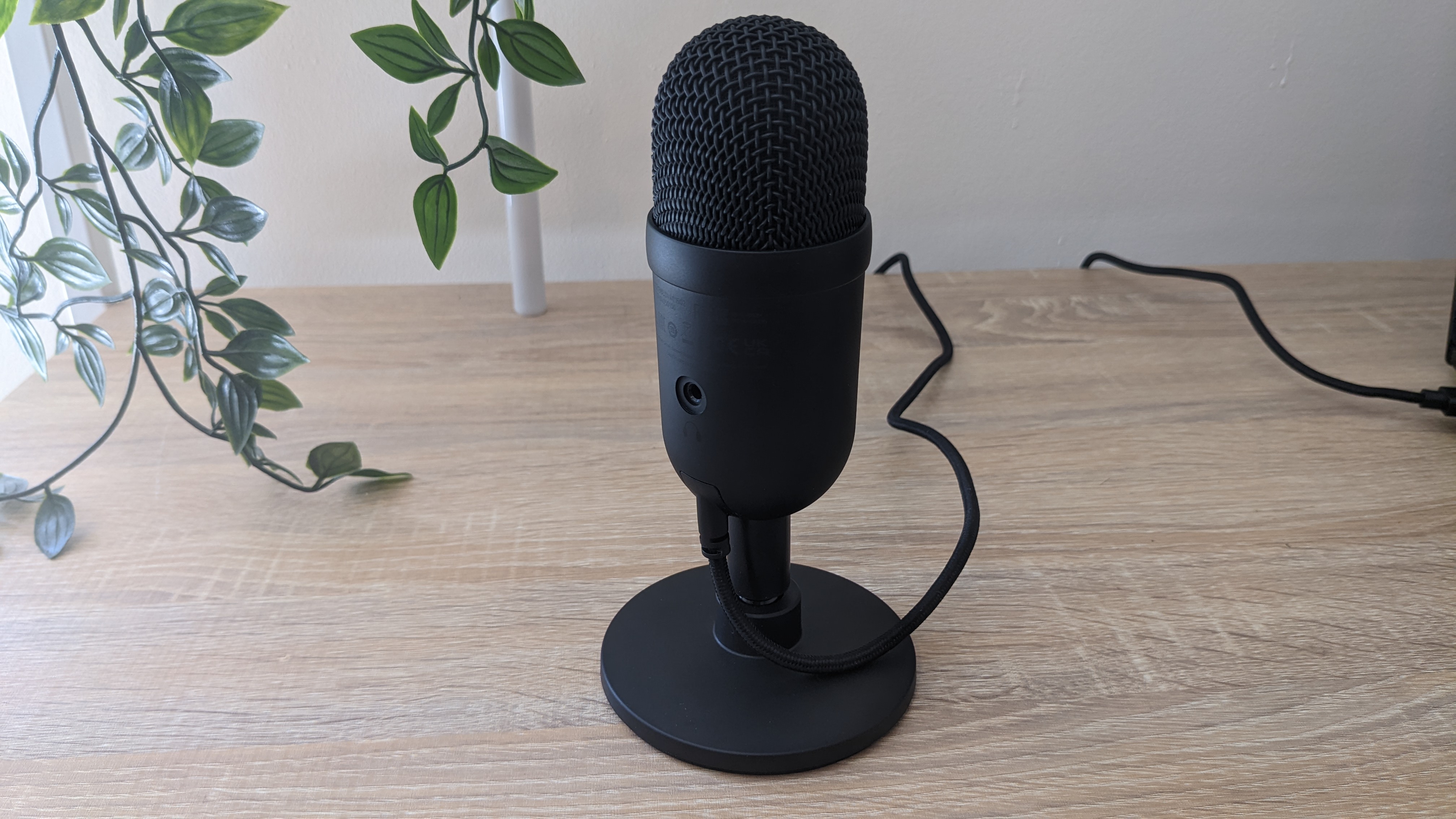
Razer Seiren V2 X: Design
- Robust casing and weighted base
- Basic (though functional) controls
- Only comes in black
Unlike the compact Razer Seiren Mini, which is available in the brand’s Mercury and Quartz (read: white and pink) color schemes, the Seiren V2 X only comes in that classic Razer black. Fortunately, this dark casing isn’t like the black metal finishes found on Razer’s Blade laptops, so it doesn’t constantly pick up fingerprints.
The base contains a weighted metal disc with a grippy foam pad on the underside, to keep the mic from moving around while it’s atop your desk. The base features a ball-and-socket design that lets you tilt the mic head in any direction by about 30 degrees. The outer casing is entirely plastic, but it’s quite durable with a nice matte finish that doesn’t feel cheap. The mic head is a domed woven metal grille that feels much better than the perforated surface of the original Seiren X.
On the front, there’s a single button to mute the mic input (which lights up bright Razer green while the mic is hot, and a dimmer red when muted) and a textured plastic dial for controlling the microphone gain. I found the dial a little small and stiff, meaning I had to grip it quite firmly with my thumb and forefinger to turn it. The mute button works fine and doesn’t produce any sound that the mic could pick up when pressed.
Around to the rear, there’s a 3.5mm headphone jack for in-situ audio monitoring, along with a USB-C slot for connecting it to your PC. The included cable is six feet long and braided for improved durability, which is great, but it’s a shaped port that prevents you from using non-proprietary cables, which is not so great
- Design: 4/5
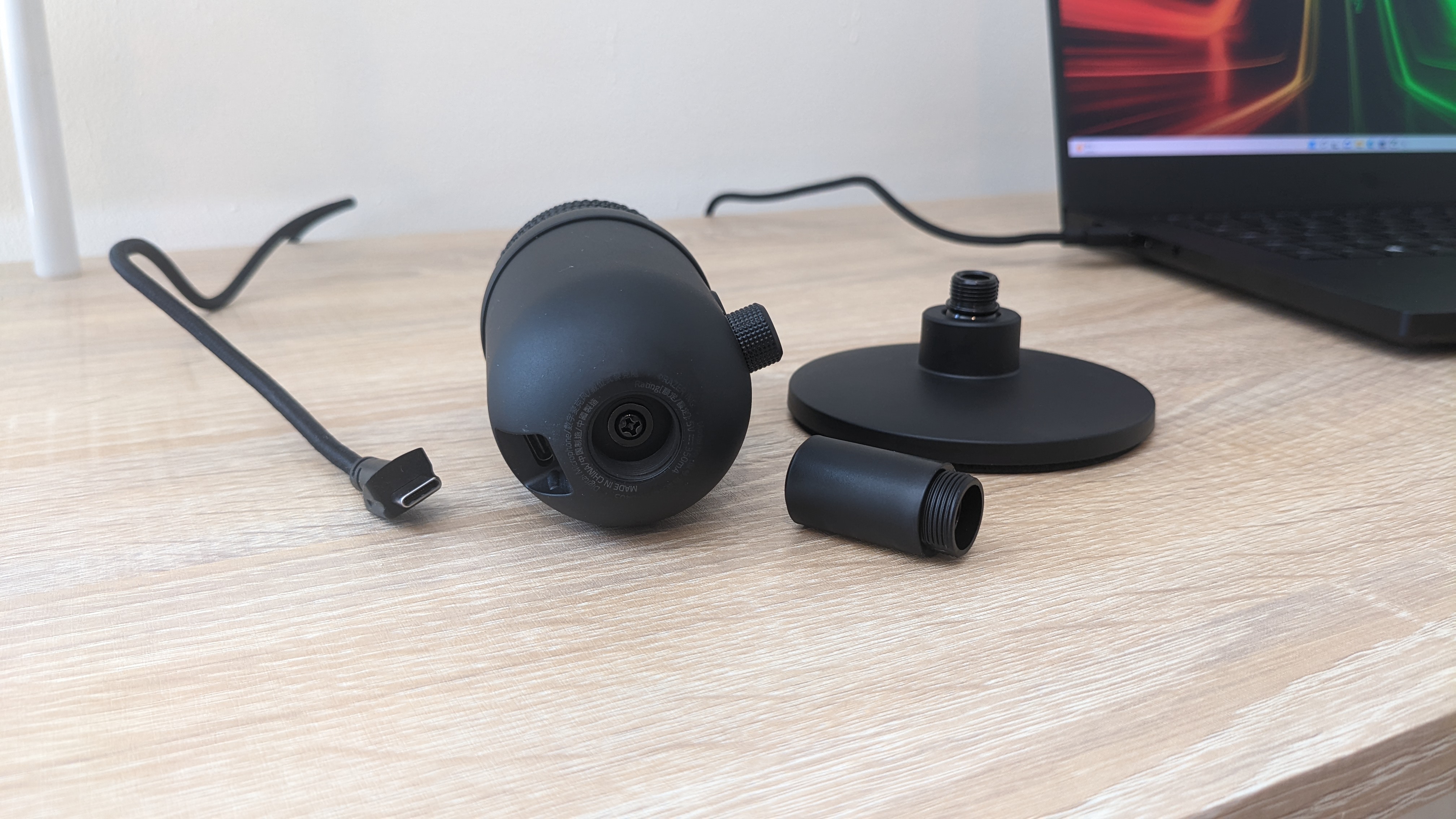
Razer Seiren V2 X: Features
- Slight improvements over the previous model
- Software is just okay
- Stream mixer works, but isn't revolutionary
In terms of physical features, there’s not a huge amount to discuss here. The Seiren V2 X has a lot of the same internals as the first Seiren X, with the only changes of note being a new 24-bit bitrate to improve the audio quality received by your PC and a slightly higher Max SPL to handle loud input sounds.
The ‘supercardioid’ pickup pattern used by most Razer microphones can’t be changed, so bear in mind that this mic is only really designed to pick up audio from one speaker (or maybe two people sitting very close together). The supercardioid pattern suppresses sound from the back and sides of the mic head, and I can’t help but feel that while the new design looks better, the old Seiren X’s monodirectional head made it clearer to users that the mic had to point towards them.
One of the big selling points for the Seiren V2 X is how much it can do with Razer’s Synapse software (which isn’t really a good thing, in my opinion). While the Seiren Mini is more of a plug-and-play affair, the Seiren V2 X benefits from a gain limiter and a stream mixer, as well as the usual selection of input and output tweaks.
The former of these two main features works automatically, dropping the mic gain very briefly in response to loud sounds. It’s actually pretty good, preventing audio distortion if I suddenly shouted ‘SNIPER!’ into the mic during a heated match in Apex Legends. The stream mixer works fine for mixing different audio sources, I guess - but you’re generally going to be much better off using third-party streaming software, like the excellent OBS.
- Features: 3/5
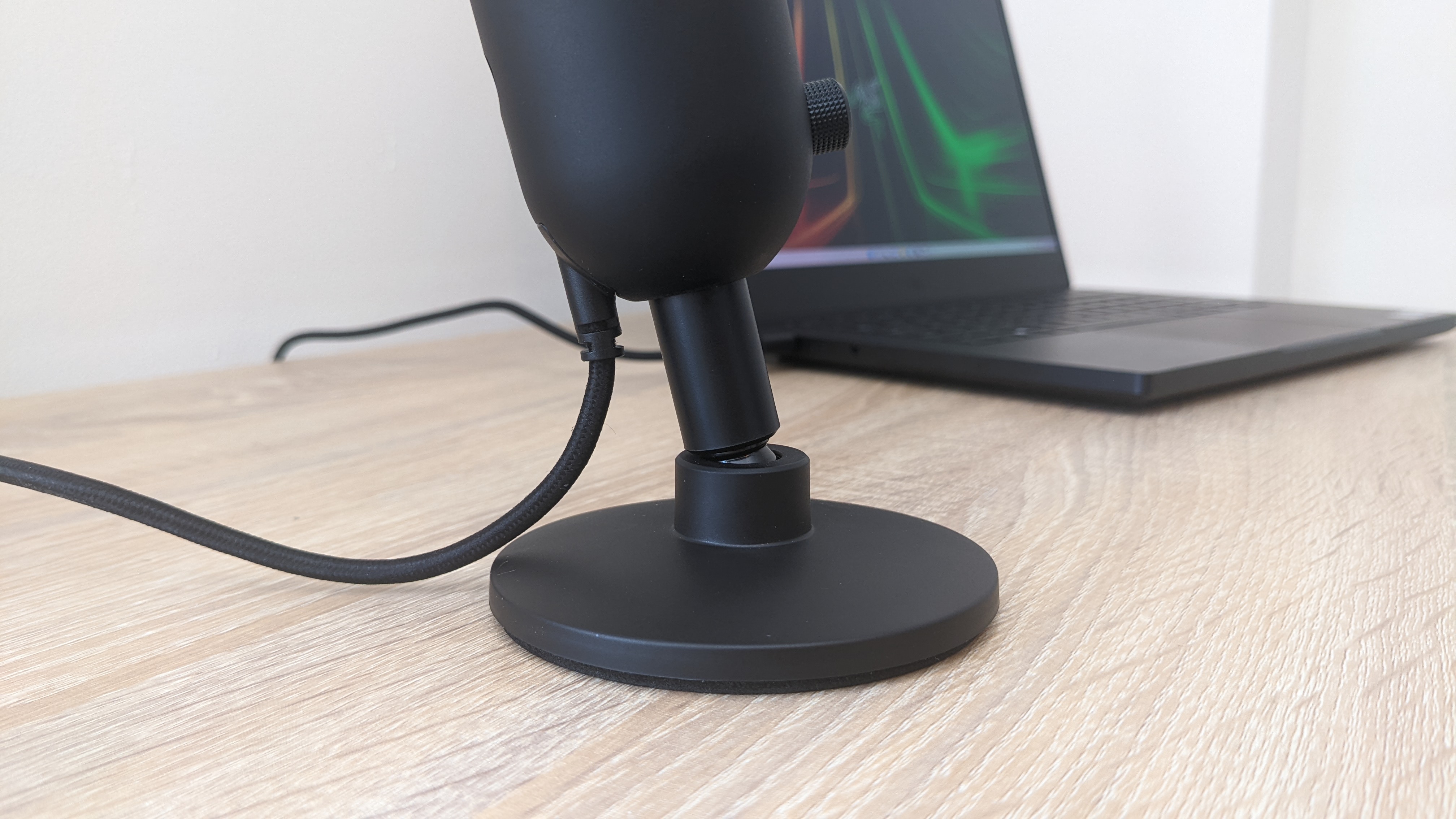
Razer Seiren V2 X: Performance
- Good maximum input volume
- Picks up keyboard clatter too much
- Gain dial is overly sensitive
First thing’s first: the maximum gain on the Seiren V2 X is great, enabling it to pick up your voice from several feet away if you speak clearly - although speech does sound a little flat. Unfortunately, it picks up a lot of background noise if you do this, so ideally you’ll want to dial down the gain and purchase a boom arc to position the mic close to your mouth. Speaking at lower gain with your mouth less than a foot away gives a nice, clear level of vocal clarity that should be great for streams or solo podcasts.
At medium gain with the mic standing on my desk to the left of my linear red mechanical keyboard, the mic was still picking up a small amount of clatter when I typed. Speech clarity is generally decent here, but if you’re a fan of clicky blue switches, you’ll want to avoid this mic.
More distant background noise is fine; on one of the days I was testing the Razer Seiren V2 X there was some noisy building work going on outside my house, which the mic didn’t pick up at all. It did, however, faintly register my dog barking and my partner talking downstairs at higher gain levels.
Part of the problem here is quite how sensitive the gain dial on the front of the mic is. There’s no LED lighting or even basic notches to measure input, and while the dial can rotate infinitely in either direction, it only requires a small adjustment to go from ‘barely registering my voice’ to ‘I have no eardrums now’.
- Performance: 3/5
Razer Seiren V2 X: Should you buy it?
Buy it if...
You want to record solo
If you’re willing to invest in a boom arm to solve the gain issues, the Razer Seiren V2 X’s supercardioid pickup pattern makes it a good choice for recording audio from one user for podcasts or YouTube videos. We’d argue that it’s actually better suited for this than streaming.
You’ve already got other Razer kit
Let’s face it: the Seiren V2 X does look pretty nice, and it’ll fit in nicely with an existing Razer-themed setup. If you’ve got even one other piece of Razer hardware, you’ll probably already have Synapse downloaded, too.
Don't buy if...
You want the best value for money
Ultimately, the Razer Seiren V2 X doesn’t really compete with other streaming mics in its price range. Cheaper USB desktop mics are available with comparable performance, and the similarly-priced Blue Yeti blows it out of the water.
You want lots of features
While it’s got some handy things to offer in Synapse, the Seiren V2 X is overall a bit feature-light. If you’re serious about your audio customization, you might want to invest in a more advanced microphone.
Also consider
Blue Yeti
Blue's Yeti microphone has established itself as an industry go-to for plug-and-play microphones. Affordable and high in quality, it's an easy win for a simpler setup.
Check out our Blue Yeti review.
Endgame Gear XSTRM
A new arrival on the microphone scene, Endgame Gear has offered a stellar first showing with its XSTRM streaming mic. It's an RGB-covered gaming-oriented product that functions amazingly, even if the AI-powered noise reduction features are bit over-hyped.
Check out our Endgame Gear XSTRM review.
XSTRM: Report card
| Value | Good quality, but somewhat expensive and doesn’t include a boom arm or pop filter. | 3 / 5 |
| Design | An improved durable design that looks great and should last for years. | 4 / 5 |
| Features | Razer Synapse is functional but unimpressive, generational improvements are small. | 3 / 5 |
| Performance | Good in certain ranges, but picks up keyboard noise and has overly-sensitive gain control. | 3 / 5 |
- First reviewed August 2022
How we test
We pride ourselves on our independence and our rigorous review-testing process, offering up long-term attention to the products we review and making sure our reviews are updated and maintained - regardless of when a device was released, if you can still buy it, it's on our radar.

Christian is TechRadar’s UK-based Computing Editor. He came to us from Maximum PC magazine, where he fell in love with computer hardware and building PCs. He was a regular fixture amongst our freelance review team before making the jump to TechRadar, and can usually be found drooling over the latest high-end graphics card or gaming laptop before looking at his bank account balance and crying.
Christian is a keen campaigner for LGBTQ+ rights and the owner of a charming rescue dog named Lucy, having adopted her after he beat cancer in 2021. She keeps him fit and healthy through a combination of face-licking and long walks, and only occasionally barks at him to demand treats when he’s trying to work from home.
